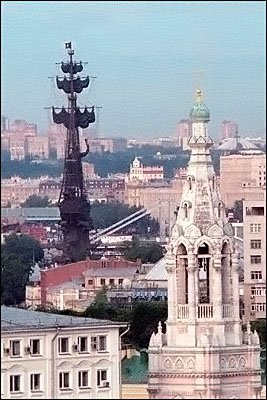
 |


| Telephoto view of the controversial memorial to Peter the Great(the dark structure on the left), shot from my room at the Rossiya Hotel. The following is from Art in America, July, 1997 by Jamey Gambrell Moscow's monumental woes - controversy over Peter the Great sculpture in Moscow, Russia Art in America, July, 1997 by Jamey Gambrell A sculpture nearing completion in the center of Moscow has provoked a serious debate on democracy, esthetics and public-decision making. The controversy centers on a more than 300-foot-high sculpture of Peter the Great by the artist Zurab Tsereteli. Tsereteli is known as a friend and favorite of the city's powerful mayor, Yury Luzhkov, and the artist has received the lion's share of municipal art commissions in recent years. The sculpture itself -- a monument to the 300th anniversary of the Russian Navy -- is a clunky, overbearing construction that has been likened to a big toy soldier stuck atop a bunch of broken model ships. Critics have lambasted it for its awkward scale, its absence of historical accuracy (Peter, for reasons the artist has never explained, is dressed in the costume of a Roman legionnaire) and just plain bad taste. Many have also lamented its placement on a small island in the Moscow River, just opposite the New Tretiakov Gallery, where it disrupts a lovely, low-slung cityscape and competes with the nearby Cathedral of Christ the Savior. The estimated price tag of $15-20 million only added to public ire. But it seems to have been the absurd idea of placing such a huge monument to Peter the Great in Moscow -- a city the Russian Tsar and founder of St. Petersburg detested -- that finally exhausted the public's patience. The campaign against Tsereteli and Peter began tentatively last winter with a few isolated articles in Moscow newspapers. A local magazine started a write-in crusade complete with bumper stickers and mail-in postcards. In December and January a group of young avant-garde artists staged widely noted protests and performances in front of Tsereteli sculptures around the city. Then a group of several hundred Moscow artists and sculptors signed a petition against Tsereteli's monopoly on Moscow public art. A turning point came when the weekly magazine Itogi ran a long article by the artist Simon Faibisovich questioning the decision-making procedures by which public funds were committed to the sculpture without competition or public discussion. In a sign that such criticism had hit a nerve, Moscow TV (owned and controlled by the city) began running sympathetic interviews with Tsereteli where he explained that the whole campaign was a plot against him. One of the artist's supporters even began handing out leaflets near the work site which claimed that the campaign against Tsereteli was a NATO-inspired scheme to ruin relations between Russia and the nations of the Caucasus (Tsereteli, though a Russian citizen, is an ethnic Georgian.) In mid-February, art gallery owner Marat Gelman called for a public referendum on the fate of the work, claiming that he could muster the 1 00,000 signatures necessary to force a vote. Suddenly anxious to save the city coffers undue expense (a referendum would cost over $10 million), the mayor met with Gelman and others to discuss possible compromises. The meeting led to the creation of a committee that included artists, architects and other public figures, which was charged with making recommendations on Tsereteli's Peter and devising procedures for commissioning future public art projects. The victory of public responsibility over bureaucratic fiat turned out to be short-lived. At least half of the committee consisted of Tsereteli supporters, according to its chair, architect Yury Avaakumov, and the result was a foregone conclusion. The mayor's office commissioned and paid for opinion polls that appeared to show that under 15 percent of the population actively wanted the sculpture dismantled and less than half would participate in a referendum. (It has been pointed out that the results might have been different had those polled been informed of the sculpture's cost -- over $17 million in municipal funds.) Basing its decision on the poll, the majority of the committee members voted to leave the sculpture in place. However, the committee also recommended introduction of a municipal law on public monuments that would require public discussion and exhibition of projects, financial disclosure and a competitive selection process, none of which were observed in the case of Tsereteli's monument. This would amount to a democratic revolution in municipal policy -- but too late to spare the Moscow skyline. Early on the morning of Apr. 1, an explosion shook a neighborhood in northeast Moscow, and the capital's only monument to the last Russian Tsar, Nicholas II, was reduced to scrap metal. The explosion was no joke: according to the police, a device containing approximately 1 1/2 pounds of dynamite was hung from the figure's hand and detonated by remote control. Erected only a few years ago, the larger-than-life statue was completely destroyed; only part of the pedestal remains. The sculptor, Vyacheslav Klykov, attributed the explosion to extremist Communist groups and "enemies of Russia," pointing out that he had been unable to have Nicholas sited in a more central location in the first place due to Communist resistance (Klykov's equestrian statue of Soviet Marshall Zhukov stands at the entrance to Red Square). There was speculation in the press and among artists, however, that Klykov himself had something to do with the explosion, and was trying to raise sympathy and funds to execute a new bronze version of the welded-copper monument. Local residents, for their part, thought that the explosion might even be related to a dispute between the Russian Orthodox Church and local gardeners over ownership of the land on which the sculpture stood. COPYRIGHT 1997 Brant Publications, Inc. COPYRIGHT 2004 Gale Group |